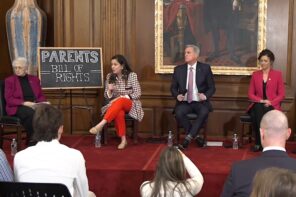In previous posts I’ve tried to provide some context for Winnifred Fallers Sullivan’s wide-ranging commentary on Hobby Lobby and Conestoga Wood, “The Impossibility of Religious Freedom.” In this final post, I want to scrutinize her argument and those of some of her critics. What precisely is Professor Sullivan’s objection to the notion of religious freedom? Addressing American liberals and the dissenters on the Court, she writes:
You cannot both celebrate religious freedom and deny it to those whose religion you don’t like. Human history supports the idea that religion, small “r” religion, is a nearly ubiquitous and perhaps necessary part of human culture. Big “R” Religion, on the other hand, the Religion that is protected in constitutions and human rights law under liberal political theory, is not. Big “R” Religion is a modern invention, an invention designed to separate good religion from bad religion, orthodoxy from heresy—an invention whose legal and political use has arguably reached the end of its useful life.
What sort of case is Sullivan making? For analytical purposes, we can read it as anthropological, legal, or moral.
As an anthropological argument, an argument about the beliefs and intentions of the Justices, it is incomplete. If Sullivan were correct that the dissenters on the Hobby Lobby Court objected to the Greens’ and Hahns’ religion simply because they objected to its public, anti-egalitarian cast, it would be difficult to explain why those same dissenters favored blanket accommodations for all such religion so long as it is professed by nonprofit corporations. On the other hand, the Justices’ behavior fits with the hypothesis that they were objecting to what they regarded as a serious misreading of the law that shifted material burdens onto women.
Absent some positive reason to think that the Justices are self-deceived, we should take their stated reasoning to express their genuine reasoning. Their stated reasoning maintains that secular for-profit corporations do not meet the definition of “persons” under the Religious Freedom Restoration Act and that religious accommodations are impermissible when they impose significant burdens on third parties. This reasoning was also on display in Holt v. Hobbs, when Justice Ginsburg approved of a Muslim-beard exemption to a prison grooming policy, citing the fact that it was not burden-shifting.
As for liberal critics of religious exemptions generally, I am not unsympathetic to Sullivan’s claim that many reserve their outrage for exemptions claimed by conservatives (in contrast, say, to conscientious objectors). Still, this is an empirical question that is far from settled. As I read the fiercer secularist critics of exemptions, such as Marcia Hamilton, their opposition rests on the principled difference between religious claims that impose significant costs or risks of harm to others and those that don’t. If that’s cultural chauvinism, sign me up.
Even if the Court’s dissenters and their liberal supporters were driven by a tacit enmity towards a particular form of religion, we could ask whether their conclusions, and the framework they presuppose, are legally sound. However, Sullivan is not simply making a technical legal argument. Responding to Sullivan at The Immanent Frame, Andrew Koppelman commends her work for masterfully conveying the “bewildering multiplicity” of “religion.” But, he says, “the question remains what to do about it.” Isaac Weiner points out that in the present context, this multiplicity of “religion” makes it “more useful than ever” as an “eminently malleable category that can be deployed to advance any number of competing ends.”
Perhaps when she claims that the category of religion has reached the end of its useful life, Sullivan is not suggesting that it serves no one’s purposes, but rather that it serves no defensible purposes. Perhaps hers is fundamentally a moral case, a case about the injustice of protecting “religious freedom.” Then the claim would not be that such protection cannot function, but that it cannot function without invidiously discriminating against citizens whose spiritual and normative commitments are not recognized as falling under the big “R.” Then the principle at stake would be the principle of equal respect and equal protection for all citizens, regardless of their spiritual and normative commitments. This much is apparent in the language of fairness, equity, and equality that recurs throughout her work. Weiner is reading Sullivan too narrowly.
Koppelman has another challenge. In order to cope with multiplicity, he says, “law must simplify.”
Accommodation must take place under some description. That description must somehow pick out valid claims from among the universe of objections to legal regulation: if all such objections are honored, the law is nullified. Any such description will force together, under a single rubric, an enormous variety of human conduct. This is an inevitable effect of any possible legal category.
In the rough-and-tumble of the law, the realistic aim is not to wash our hands of reductive categories, but to adopt the least arbitrary or unfair categories. If religion is to be the object of accommodation, the law must manage its ambiguity. If religion is not to be the object of accommodation, then what is, and what reason is there to think that it is a less arbitrary or unfair category than religion?
The straightest path out of this dilemma is to say that no one gets accommodations, or at least not accommodations that shift material burdens to third parties, a position Brian Leiter defends in his recent book, Why Tolerate Religion? Still, Koppelman observes that even many distinguished legal theorists and philosophers who want to do away with the accommodation of religion as such want to retain the practice of accommodation. They have claimed that “the proper object of the law’s solicitude is not religion, but something else,” such as “conscience” or a “source of meaning inaccessible to other people.”
The problem with these candidates, he claims, is that any “single factor justification for singling out religion will be both overinclusive and underinclusive.” Some religious claims worthy of protection, for example, are not claims of conscience, and not all claims of conscience are worthy of protection. He argues that in order to capture the most of what is worthy of protection while excluding the least, we need the concept “religion” as “an adequate proxy for multiple goods”:
“Religion” denotes salvation (if you think you need to be saved), harmony with the transcendent origin of universal order (if it exists), responding to the fundamentally imperfect character of human life (if it is imperfect), courage in the face of the heartbreaking aspects of human existence (if that kind of encouragement helps), a transcendent underpinning for the resolution to act morally (if that kind of underpinning helps), contact with that which is awesome and indescribable (if awe is something you feel), and much else besides. Each of those goods is, at least, more likely to be salient in religious than in nonreligious contexts.
As a thumbnail sketch of what big “R” Religion is all about, this list of goods is admirably clear. But for precisely that reason it begs the question against Sullivan and others who speak for the equal dignity of citizens whose lives do not aim at the alleged goods of ineffability, salvation, or transcendence. What reason is there to think that the goods on Koppelman’s list and only these goods are worthy of protection?
For those opposed to the regime of religious freedom, the question is what could replace it. Is there a system that would be morally preferable yet also administratively implementable? Although her recent article doesn’t address it, Sullivan’s 2005 book of the same name closes by gesturing towards an alternative.
What would be lost if law focused not on the special case of religion but on the accommodation of difference generally, and what compromises any such accommodations imply for commitments to equality? Without an explicit protection for religion, guarantees of freedom of speech, of the press, and of association would continue to protect most of those institutions, including religious ones, usually thought necessary for a free democratic society.
Under this legal regime, religious individuals and communities would “have to make arguments for the special legal accommodation of difference to legislative bodies.” Those making a case for “differential treatment would be required to make a very strong showing, as in race cases, of past discrimination or present need, to justify special legal treatment.” While these remarks are promising and suggestive, they do not constitute a workable theory. Attempts to construct such a theory—and attempts to show that there could be no such theory—presently preoccupy much legal scholarship. Insofar as there is no feasible alternative to a regime of “religious freedom,” Koppelman’s larger challenge remains in force: Religious freedom may be impossible, but compared to what?
In her comment on Hobby Lobby, Sullivan asserts that “the business of religious studies scholars to explain these phenomena, not to decry them.” There is no question that she has made unrivaled contributions to our understanding of the phenomenology of religion under the law.
At the same time, as a scholar-explainer of phenomena, Professor Sullivan has distinguished herself with a rhetoric that decries the “impossibility” and unmasks the “lies” of religious freedom in ringing tones. When it comes to the task of constructing a legally feasible and morally superior alternative, she has chosen to remain in what Rebecca West called “the deep peace of being in opposition.”
RD contributing editor Austin Dacey will be writing a series of posts in the coming months as part of a joint project between The Immanent Frame and Religion Dispatches made possible by the generosity of the Luce Foundation.




